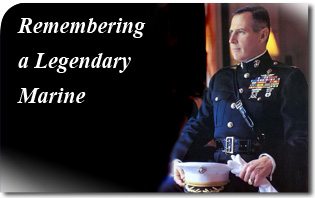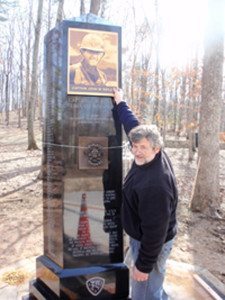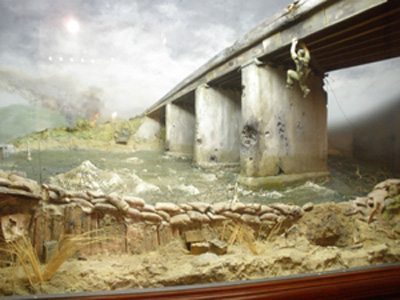 Anniversaries can be occasions of both joy and sorrow. On March 2, 2012, 112 Vietnam Veterans came together at the Marine Museum in Quantico, Virginia for an anniversary that was both. They chose that day to honor their captain, the late Colonel John Ripley with a monument, because it was on that exact day, forty-five years ago, that they endured a ferocious battle where many others lost their lives. It was a sorrowful anniversary because their “skipper” 1 was not there with them. A joyful one because he received the honor he so richly deserved.
Anniversaries can be occasions of both joy and sorrow. On March 2, 2012, 112 Vietnam Veterans came together at the Marine Museum in Quantico, Virginia for an anniversary that was both. They chose that day to honor their captain, the late Colonel John Ripley with a monument, because it was on that exact day, forty-five years ago, that they endured a ferocious battle where many others lost their lives. It was a sorrowful anniversary because their “skipper” 1 was not there with them. A joyful one because he received the honor he so richly deserved.
Birth of a Legend
Chuck Goggin, a former professional baseball player, member of Col. Ripley’s Lima Company and key promoter of the Ripley monument

was the MC for the day’s events. This was “our way to honor our skipper.” He then explained the significance of the day they chose for the dedication and reflected on the March 2 battle which pitted 215 Marines against 1500 Communist North Vietnamese. “The odds were great,” Mr. Goggin recalled, with a touch of bravado that drew a chuckle from the audience.
By the time the dust settled in the hours-long conflict, Lima Company lost 22 men but were ultimately successful in repelling a much superior force. Newspapers back home were as surprised with the final outcome as were the Communist NVA who were routed from the battlefield. One paper carried a front page article about the battle with the title Ripley’s Raiders Rout NVA Force. From that day forward, Lima Company continued to use it. The name stuck and a legend was born.
Echoing into Marine Eternity
That legend lives on in the living Raiders who wore red hats on the day of the dedication, distinguishing them from other visitors to the museum. I had the chance to speak with many of them about their late captain, John Ripley and what he meant to them.
Leo Geysa succinctly described his former captain as the “the heart and soul of the unit,” and explained how they knew him both in war as their commanding officer and as a civilian and took time to explain the difference.
The principle which he most embodied as a Marine captain, Mr. Geysa explained was discipline. “He molded us to be like he was,” he explained, “and that was Force Recon. 2 That is the way he ran his outfit. He was very disciplined, very tight and very aggressive. He was actually the one man who led from the front.”
Glenn Johnson, from Rochester New York, echoed the same sentiments. He did not actually serve with Ripley’s Raiders but fought with Colonel Ripley before the unit was formed. Nevertheless he felt obliged to make the trip to Quantico for the monument unveiling. Mr. Johnson expressed his amazement at the “ridiculously small number of men – only 98,” Colonel Ripley lost during the year when the Raiders were in the bush almost constantly.
“Discipline was the value he most embodied,” Mr. Geysa reiterated. There is a huge difference between officer and enlisted man, he continued, and Colonel Ripley understood the need to keep that in place. “So discipline is what he stressed.”
The words which best described the man he got to know after Vietnam were love and friendship for the men with whom he served.
“He went out of his way to help his Marines,” Mr. Geysa said. “He got to meet them personally at the reunions and got to know them as individuals. He WAS Ripley Raiders,” he concluded and “his life will echo into Marine eternity.”
George Webb is from Middletown, Delaware and described the intensity of the struggle days after the March 2 battle. During one skirmish with the enemy he was badly wounded and had to be evacuated. When asked what value or principle Colonel Ripley most embodied he did not hesitate, “God. I would have followed him to hell,” he concluded.
Greatest Man to Ever Wear an American Uniform
Like others who fought with him, Mr. Geysa took time to point out the moral integrity of the man. Marines would sometimes question Colonel Ripley on his return trip from R & R and were curious to find out that he did not cheat on his wife. According to Mr. Geysa, their skipper told fellow Marines exactly what he told Hollywood producers interested in doing a movie on him; “I have never been unfaithful to my wife Moline and I never will be.”
Glenn Johnson recalled the humility of the man, but also his moral courage in standing up to tough issues. “He did not mess around,” is the way Mr. Johnson explained it, and “he did not play political games.”
The most moving tribute came from former POW Paul Galanti, Colonel Ripley’s best friend. He was responsible for the diorama inside

Bancroft Hall of the United States Naval Academy which depicts Colonel Ripley dangling below the Dong Ha Bridge with two satchels of plastic explosives. By destroying the bridge he halted the largest communist offensive of the entire Vietnam War and earned the Navy Cross; our nation’s second highest award for valor.
Mr. Galanti began by saying that Colonel Ripley was “the greatest man ever to wear the uniform of the United States of America.” As he continued, a Ripley Raider standing in front of me began to wipe away tears as he recalled the memory of his beloved captain. A gentle rain began to fall which led another Raider to poetically comment how the heavens were weeping also.
Paul Galanti finished his words with a stirring affirmation. He was convinced that, had the North Vietnamese been able to cross the Dong Ha Bridge they would have continued their march south and ultimately crushed Saigon.
“I owe my freedom to John Ripley,” he said. “Had he not [blown the bridge], I would still be there, with the rest of the American POWs.”
Marines come and go but some leave a greater mark than others. Now, thanks to the efforts of Ripley’s Raiders the legend of Colonel John Ripley will, as Leo Geysa said so well, echo into Marine eternity.

